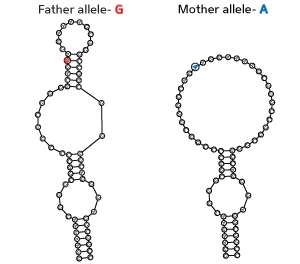Single-nucleotide differences in genomic sequence between two individuals, such as the substitution of guanine (G) with adenine (A), can considerably alter the structure of the resulting mRNA transcript. Credit: Genome Institute of Singapore
The information contained within a messenger RNA (mRNA) transcript goes beyond the protein recipe embedded in its sequence. mRNAs consist of single strands of nucleotides that can pair with each other in the same way as double-stranded DNA molecules. The resulting 'secondary structures' help determine when and how the encoded protein gets produced.
Researchers led by Yue Wan of the A*STAR Genome Institute of Singapore and Howard Chang of Stanford University in the United States have applied a powerful experimental technique to build a detailed map of secondary structures for the entire human mRNA 'transcriptome'.
Their Parallel Analysis of RNA Structure (PARS) method entails isolating the total mRNA content of a biological sample, then treating it with two different enzymes that selectively cut single- or double-stranded RNA segments. By using sequencing technology to map these cut sites, the researchers could chart the secondary structure of each mRNA transcript.
The analysis uncovered some interesting general features of mRNA structure. For example, protein-coding regions had less structure than noncoding regulatory sequences, particularly in segments involved in splicing—an enzymatic process that expands the number of proteins encoded by a single transcript. Additionally, nearly 10 per cent of the mRNAs the team examined assumed multiple secondary structure arrangements, suggesting that 'switching' between conformations plays an important regulatory role.
The researchers also investigated instances where mRNA structure is affected by differences in the genomic DNA sequence from which it was transcribed. "There is extensive genetic variation between individuals," explains Wan. "To understand the extent to which this causes structural alterations in humans, we performed a genome-wide analysis in a family of three individuals." This showed that seemingly minor differences can have a considerable impact: roughly 15 per cent of the single-nucleotide sequence variations between individuals caused structural changes in an mRNA (see image).
Although other researchers predicted that genome sequence differences would have such an effect, Wan's findings represent the first direct demonstration of the extent of this phenomenon. "We identified over 1,900 nucleotide variants that cause structural changes in the human transcriptome—far more than anybody else has discovered previously," he says.
In several instances, the researchers found evidence that these variant-associated changes may impact gene regulation, including protein production, and therefore contribute to certain disease states. "This work was done on healthy individuals, but our findings suggest that some mutations may cause disease by altering gene regulation," says Wan. "Future work could compare diseased with normal tissues to identify and characterize structure-changing mutations."
More information: Wan, Y., Qu, K., Zhang, Q. C., Flynn, R. A., Manor, O. et al. "Landscape and variation of RNA secondary structure across the human transcriptome." Nature 505, 706–709 (2014). dx.doi.org/10.1038/nature12946
Journal information: Nature




















